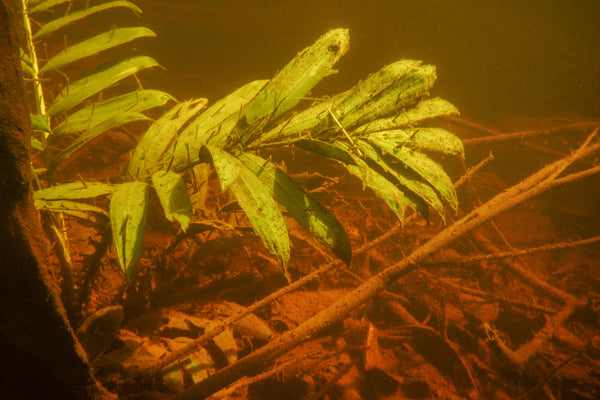- Continue Shopping
- Your Cart is Empty
With fronds like these...
One of the best parts about playing with blackwater, botanical-style aquariums is that we've tried all sorts of interesting materials in our hardscapes. It's no longer a mindset of, "Throwing _____ in your tank is weird!" Now, it's more like, "Has anyone tried________ before?"
How can I not love this stuff?
I know we've talked about food webs" in our botanical-influenced aquariums, and some of us are starting to experiment with incorporating items like small aquatic crustaceans and worms (e.g., Daphnia and "Black Worms", etc.) into our "pre-stocking" regimens, and this is creating some interesting results!

What interests me of late is the long-term "functionality" of our botanical aquariums, not just from an "environmental" perspective, but from the standpoint of supplemental food production.
We read a lot in scientific papers about fungal and microbial growth of organisms in wild leaf litter beds, and I am pretty confident that some of the same processes occur in the leaf and botanical beds we create in our aquariums.

Obviously, some fishes utilize these materials as part of their diets at some points in their lives.

We've postulated that fry will certainly make use of many appropriately-sized organisms which occur naturally. We may, at some future point, even get a feel for which botanical materials can do the best job at fostering these sorts of populations...perhaps, a different way entirely to look at the way we select and employ botanicals in our systems!
Like, selecting certain botanicals specifically for "cultivating" microorganisms and small crustaceans to use as supplemental food sources for our fishes!
I can't help but wonder if our botanical tanks, simply by virtue of the fact that they have accumulations of decomposing plant materials, foster a significant enough of a population of "edible" microorganisms for fry to consume.
In theory, I'd think so. However, the aquarist in me can't help but think that we should also consider "inoculating" our aquariums with pure cultures of organisms like Paramecium and various "infusoria" at various times during the "startup" phase of our aquarium to sort of "kickstart" the populations, if reproduction of fishes is our goal.

And of course, part of me wonders if having a larger and more diverse population of microorganisms as "consumers" would make a more diverse and efficient botanical-style aquarium.
I think that it would.
And one of the botanicals I think about a lot lately in this context is the palm frond.
Now, with many of us playing with palm fronds of late, I can't help but wonder if, both by virtue of their surface area AND their composition, that these support larger populations of both "food" microorganisms and maybe even beneficial bacteria for denitrification.
In addition to looking good, do these materials actually help make for a more stable system from a biological standpoint? I mean, they do break down over time, but...

I would imagine that palm fronds provide interesting areas for fry to both shelter and graze upon, so it might not be a bad idea to include them in many aquariums intended to rear fry.
Other than taking up physical space, I'm not seeing a huge downside to this...that is, if you're trying to rear fry in a more "natural-type" setup, as opposed to a more sterile, functional breeding setup.

And the aesthetic they bring is nothing short of amazing!

Palm fronds are interesting from a "functional aquascaping" perspective, not only because they serve to foster beneficial life forms (and that thought of surface area for biological filtration), but from a standpoint of demarkation of territory, and serving as natural "flow deflectors", and of course, blocking out some light for fishes that prefer dim conditions (I don't know why Boraras species keep coming to mind here). I think they remind me very much of a piece of driftwood, in terms of the possibilities to support a population of fishes.
I could envision, because of their large size, yet flexible nature, an entire community" of small fishes, ranging from Angelfish to Bettas to cichlids, to loaches, Badis, and catfishes, living out a large portion of their lives in and among submerged palm fronds. The sense of protection and the easy availability of food could really lead to some interesting, natural behaviors in our fishes...particularly the really small fishes that certain individuals among us favor...

So, a palm frond as a habitat area is most intriguing to me,almost a sort of "freshwater reef", really.

And I can visualize various behaviors and other aspects of our fishes being influenced by these items in their environment. No doubt palm fronds have some ecological role in nature that benefits fishes.

Those of you that have also begun experimentation with palm fronds are telling me not only are you intrigued by these ideas as well, you're also loving the aesthetics they bring!

I suppose it would be easy for some negative types to simply call our recent infatuation with Palm fronds as a sort of "trend", but the reality is- it's more of an evolution of what we've been doing with botanical aquariums: Incorporating different materials in different ways; evolving both technique and aesthetic as we go.
Much groundwork has been laid by hobbyists like Rene Claus and Tai Strietman, who have played with palm fronds for some time, and much credit should be given to them for leading the way!

Like so many things in our evolving world of botanical, blackwater aquariums, embracing natural processes and behaviors is best amplified by embracing natural materials, utilized in different ways.
With form, function, utility- and all sorts of possibilities in between, Palm fronds are here to stay, in my opinion, as a "tool" in our botanical toolkit...
And if our fishes (and microbial populations) could talk, I imagine they'd be inclined to agree!
That's a "win-win" in my book!
Stay excited. Stay creative. Stay experimental. Stay engaged.
And Stay Wet.
Scott Fellman
Tannin Aquatics











Scott Fellman
Author